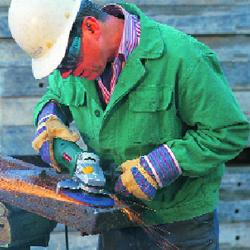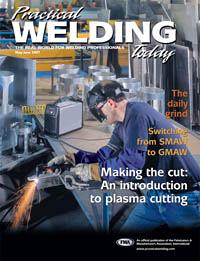Senior Product Manager
- FMA
- The Fabricator
- FABTECH
- Canadian Metalworking
Categories
- Additive Manufacturing
- Aluminum Welding
- Arc Welding
- Assembly and Joining
- Automation and Robotics
- Bending and Forming
- Consumables
- Cutting and Weld Prep
- Electric Vehicles
- En Español
- Finishing
- Hydroforming
- Laser Cutting
- Laser Welding
- Machining
- Manufacturing Software
- Materials Handling
- Metals/Materials
- Oxyfuel Cutting
- Plasma Cutting
- Power Tools
- Punching and Other Holemaking
- Roll Forming
- Safety
- Sawing
- Shearing
- Shop Management
- Testing and Measuring
- Tube and Pipe Fabrication
- Tube and Pipe Production
- Waterjet Cutting
Industry Directory
Webcasts
Podcasts
FAB 40
Advertise
Subscribe
Account Login
Search
Grinding the way to safety
Addressing safety concerns with nonlocking paddle switch grinders
- By Terry Tuerk
- May 8, 2007
- Article
- Finishing

Nonlocking paddle switch grinders require the user to hold down the paddle switch while in use. Once the paddle switch is released, the grinder turns off automatically.
Although hand-held angle grinders have been around for many years in the metal fabrication industry, they now are being used more frequently by professionals in the mechanical contracting, autobody, masonry, and painting industries for grinding, cutting, and polishing.
As power tools have become more advanced, angle grinders also have improved. Not only are they available in additional sizes of 4, 41/2, 5, 6, 7, and 9 inches, but during the last 10 to 15 years, while the motors have become more compact, they have become more powerful. Yesterday's 9-amp motor now is 12 amps, a 33 percent power increase.
While users are cheering these technological advancements, safety professionals are becoming gradually more concerned. Users sometimes don't realize that the increased power requires them to be even more cautious when using the tool because there is a greater chance of losing control of it. To go hand-in-hand with the improved performance advantages of angle grinders, manufacturers have been working to improve operator safety features as well.
Grinder Options
As their name implies, traditional top-switch angle grinders have an on/off switch on the top of the grinder that can be locked in the "on" position. If you lose control, the tool continues to run and the wheel continues to spin, causing damage to anything and anyone it encounters before you turn it off.
Because of these safety concerns, nonlocking paddle switch grinders, which have been manufactured for many years, are starting to gain headway in the industry. Instead of a lock-on switch, these grinders feature a paddle alongside the grip. When you grip the handle, you also hold down the switch that turns the grinder on. If you lose control of the tool, you no longer will be holding down the paddle switch, and the grinder will turn itself off.
Although using a nonlocking paddle switch grinder for a long period of time can become tiresome, the safety benefits often outweigh the additional exertion needed. In fact, safety personnel are advocating the use of these grinders and are now influencing what tool professionals use and distributors have in stock.
From the Field
Ray Little, general manager of Tol-co Inc., a company that provides tools and equipment for the construction industry, said that safety is a bigger issue for his customers now than it ever was before. Many tools that he sold in the past can't be sold today unless they are equipped with additional safety features.
"Plants don't like a grinder switch that locks on," Little said. "Some plants won't even allow those types of grinders in their plant at all. They want it to have a safety shutoff; if the hand comes off, the grinder cuts off."
He said right now the industry dictates what he orders, and that he is ordering twice as many nonlocking paddle switch grinders as locking top-switch grinders.
"I can see a point when I won't need to buy locking top-switch grinders anymore," he said.
Distributors aren't the only ones seeing an increase in the use of nonlocking paddle switch grinders. At one of Teton Industrial Construction Inc.'s job sites, all of its more than 120 grinders are nonlocking paddle switch types.
"We aren't allowed to use the locking ones because of safety purposes," said Billy Babin, project superintendent at Teton. "They can be extremely dangerous if you don't use them properly, and the safety of our operators is one of our main concerns."
He said that using any grinder is similar to using a weapon. If you put either in the wrong person's hand, it can be dangerous with serious consequences. But with the proper training, either is an effective tool. Babin carefully oversees the use of angle grinders on-site, requires double eye protection, and trains his operators to know the proper positioning to keep sparks and debris away from their bodies.
Safety First
Even for those who choose not to use nonlocking paddle switch grinders, safety is an important issue. The following are grinder use tips to make sure you are protecting yourself, no matter what type of grinder you use.
Always Expect the Unexpected. When using a grinder, be aware of your environment and situation. Keep your mind on the task, and be prepared for the possibility of kickback. If you are alert, the tool can be more easily controlled, and potentially dangerous situations can be averted.
Wear the Proper Attire. You always should wear the proper protection equipment when working with grinders. Sparks and metal often fly off a workpiece, so be sure to wear safety goggles, arm protection, and other safety clothing, as well as hearing protection.
Use Appropriate Safety Features. The guard should be on the tool and used at all times. Although some operators complain the guard can get in the way of the work in difficult-to-reach places, technology has improved, making guards that are easily adjustable and positioned for the best operation. You also should choose a grinder with a safety slip clutch or other electronic clutches that prevent kickback.
Read the Manual. It is important to read the instruction manual and understand the tool before using it in a work environment. Many of the tool's additional features will be explained, which will help you use the tool properly and to your best advantage.
Use Both Hands. By using the side handle and placing both hands on the tool during operation, you will have more control over the tool under high-torque situations when the wheel does bind. In addition, many side handles now minimize vibration, which reduces the risk of hand/arm vibration syndrome.
Use the Correct Wheel Size. It is always important to use the proper grinding wheel size when working with an angle grinder. Using wheels that are the incorrect size increases the risk that the wheels may shatter or explode at very high speeds. The wheel always should have a speed rating that is higher than the no-load speed of the tool.
Grinder operators are benefiting from the improved safety and performance of nonlocking paddle switch grinders, which will continue to fuel the growth of these powerful and versatile tools.
About the Author
Terry Tuerk
1231 Wilson Drive
West Chester, PA 19380
800-638-2264
About the Publication
Related Companies
subscribe now

The Welder, formerly known as Practical Welding Today, is a showcase of the real people who make the products we use and work with every day. This magazine has served the welding community in North America well for more than 20 years.
start your free subscription- Stay connected from anywhere

Easily access valuable industry resources now with full access to the digital edition of The Fabricator.

Easily access valuable industry resources now with full access to the digital edition of The Welder.

Easily access valuable industry resources now with full access to the digital edition of The Tube and Pipe Journal.
- Podcasting
- Podcast:
- The Fabricator Podcast
- Published:
- 04/16/2024
- Running Time:
- 63:29
In this episode of The Fabricator Podcast, Caleb Chamberlain, co-founder and CEO of OSH Cut, discusses his company’s...
- Trending Articles
Sheffield Forgemasters makes global leap in welding technology

Welding student from Utah to represent the U.S. at WorldSkills 2024

Lincoln Electric announces executive appointments

Lincoln Electric acquires RedViking

Engine-driven welding machines include integrated air compressors

- Industry Events
16th Annual Safety Conference
- April 30 - May 1, 2024
- Elgin,
Pipe and Tube Conference
- May 21 - 22, 2024
- Omaha, NE
World-Class Roll Forming Workshop
- June 5 - 6, 2024
- Louisville, KY
Advanced Laser Application Workshop
- June 25 - 27, 2024
- Novi, MI


























